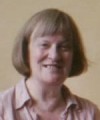Recognising endometriosis advocates: Ailsa Irving
Ailsa Irving founded the National Endometriosis Society (NES) in the UK in 1981, and helped establish self-help groups across the country.

Ailsa Irving, Founder of the National Endometriosis Society in the UK
Ailsa had struggled with endometriosis for fifteen years before she met others with the disease.
She then mobilised these women and channelled their talents and medical knowledge into creating a charity that supports women to this day – each and everyone being a very important cog in the wheel that kept growing the NES.
Ailsa moved the endometriosis agenda forward in the days before the internet – a remarkable, and time-consuming, feat when all communication was either paper-based or on the telephone!
Getting involved with endometriosis
In 1981 Ailsa Irving met Maureen in a hospital gynaecology department – Maureen was the first person she met who had endometriosis. Ailsa had struggled with the illness herself for 15 years without knowing anyone else who had it.
This first meeting was a big revelation and she realised how much could be gained from meeting others in a similar situation. Ailsa was always interested in researching and it seemed natural to find out much more about endometriosis and how it affected other women.
Making a difference for women with endometriosis
Getting women with endometriosis together seemed like an exciting challenge so Ailsa placed an advert to meet other women with endometriosis in the personal column of The Guardian newspaper on 7 February 1981, resulting in around 40 replies from women all around the UK – the first, that very same evening, from Lesley Mabbett, who lived in Stockport. Lesley had severe endometriosis and, being experienced in health education, later became a trustee of the charity.
The first person she met from the advert, however, was Shelley Walker – a young nurse. Ailsa and Shelley met – on 18 February 1981 – and produced the first newsletter on 20 February 1981 to send to everyone who had responded to the advert. This being before the days of the Internet, this newsletter was typed up, photocopied, and distributed via the postal service, involving the stuffing of envelopes and the licking of stamps!
On 1 March 1981 – the first meeting of the NES – there were only four women present (meeting at Ailsa’s house) but as an example of how this meeting sparked their curiosity and enthusiasm, Ailsa recalls three of them had had a bad attack of glandular fever in their teens. It seemed like more than a coincidence and something to look into. From there on, Ailsa started investigating and researching women’s experiences with endometriosis.
In early 1982 the Jill Rakusen article on endometriosis and the self-help group appeared in Good Housekeeping magazine and brought in over 800 replies resulting in the establishment of a fine team that, together, made it all happen. The charity registered in 1982 with four trustees who all played an equally important role in its development.
Tasks such as arranging workshops, public speaking, developing the newsletter and educational leaflets, and general admin were divided between the trustees – and many, many volunteers who, together, made great strides.
Caroline Hawkridge were one of those, who arrived on the scene early through the Good Housekeeping article and, as a trustee, was a tremendous boost to the charity resulting in the 1989 publication of the first British book on endometriosis Understanding Endometriosis.
Ailsa’s major achievements in moving the field of endometriosis forward
- Setting up the National Endometriosis Society [now Endometriosis UK, ed.] following the advert in The Guardian and sticking with it. Ailsa modestly believes that had she not done so someone else would (the time was ripe!) but reality is that SHE did it!
- Helping establish the self-help element which was so valuable to so many women. She encouraged the formation of self-help groups and soon there were many of these across the United Kingdom that thrive to this day.
- Being able to use her home as a base for an ‘office address’ and to house all the admin, organise the volunteers, group meetings, etc from 1981 to 1990 when the NES finally received funding to set up an office proper.
- Researching and compiling the bi-monthly newsletter for twelve years was always a pleasure for Ailsa.
- Finding out how much homeopathy and other alternative methods helped – sometimes surprisingly more so than conventional medicine.
- All the publicity she generated through magazine articles, etc, resulting in endometriosis being much more recognised by both the public and the medical profession thus making life so much easier for the next generation.
![]() Thank you from “the next generation” for all that you did, Ailsa – we hope to continue to make more strives for the generations after us also!
Thank you from “the next generation” for all that you did, Ailsa – we hope to continue to make more strives for the generations after us also!
Where is Ailsa Irving now?
Ailsa retired from the civil service in 1990 for medical reasons. After retiring from her work with the charity more than twenty years ago she is still in touch with many of the original team who became close personal friends and who still support one another in everyday life – something to cherish.
Although Ailsa’s health and mobility are not so good now she still pursues her interests – one being genealogy – having found over 4,000 people for her own family tree, she researches family history and family trees for others and thoroughly enjoy this addictive hobby.
UPDATE: Ailsa died on 17 November 2022 → OBITUARY
See also
→ National Endometriosis Society celebrates 25 years (a trip down memory lane!)
→ National endometriosis support organisations
→ Complementary therapies for endometriosis
→ Coping with endometriosis
→ Self-help books on endometriosis






